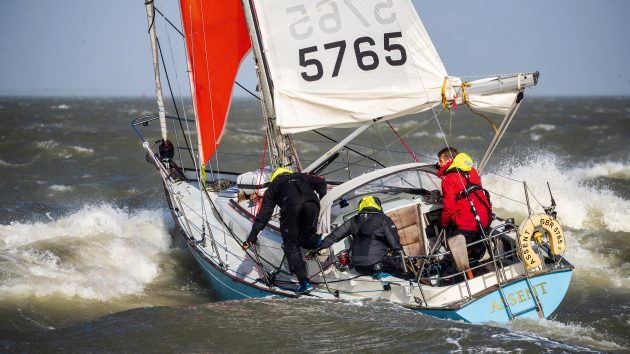James Stevens considers a problem sent in by a Yachting Monthly reader who asks how to recover from a violent gybe at sea?
It is the roughest sea Simon has ever experienced. He and his four crew are sailing eastwards on his classic 1960s 12m wooden sloop, Sea Thrift, towards the Azores with about 500 miles to go. Fortunately it is daylight for the next few hours.
Simon is an experienced sailor and his crew are all reasonably competent. Sea Thrift is well kitted out for ocean cruising with the recommended safety equipment and satellite communications.
The wind is Force 8 and freshening. The boat and crew are broad reaching with a triple-reefed main and storm jib. Simon reckons it is time to drop the main.
As he briefs the crew in the cockpit, shouting in the wind, the helmsman loses concentration. The yacht accelerates down a wave and gybes. The mainsail tears from leech to luff. As the yacht turns beam on to the sea, a breaking wave rolls over the deck and lifts off the hatch over the main saloon.
Article continues below…
How do you recover a man overboard?
Paul and Emma own a 10m yacht and are day sailing with Paul’s parents on a fine day in early…
The forecast is unsettled, should you leave harbour?
Bill is in Plymouth in September planning a passage to the Med. He has decided that the first leg is…
The hatch is still just attached by a hinge but the saloon is open to the sea.
During the gybe, Jim, one of the crew members, was sitting in the path of the mainsheet and has been hit pretty hard. He is injured and clutching his arm and crying in agony. The remaining three crew are fortunately all ok but still badly shaken by the experience.
They look to Simon for the next instruction. What would you do in his position? What should be the main priorities?

In heavy weather downwind, things can go wrong quickly, but how would you react when they do?
How to recover from a violent gybe at sea
The man with the injury and the flogging mainsail will be making the most noise but in my view the most immediate problem is preventing water from entering the boat’s main saloon.
The yacht needs to be steered downwind and the hatch repositioned and lashed down – not easy in a big sea. If the hatch is lost the gap must be covered with a tarpaulin or something which will keep most of the water out.
The boom will have to be sheeted in or lashed down to prevent it from scything across the deck. The main halyard can be released but the flogging remains of the mainsail will have to stay on the mast for the time being.
The amount of water below should be checked and a crew member needs to start pumping. Simon needs to have a plan for abandonment if the water level is rising uncontrollably. If so, a Mayday call should be sent.
It is now time to look at the casualty.
Sea Thrift is out of range of lifeboats and SAR helicopters. A call ashore to Falmouth Coastguard by satellite phone will be a way of accessing advice from a doctor. If the casualty has a really serious injury, another vessel might be diverted towards them, but either way, the injured person is going to be on board for some time. Making him comfortable and providing the appropriate first aid is the best they can do before help arrives.
In situations like this a skipper is tested to the limit. The ability to think, prioritise, stay in control and lead the crew can be a matter of life and death.
Enjoyed reading this?
A subscription to Yachting Monthly magazine costs around 40% less than the cover price.
Print and digital editions are available through Magazines Direct – where you can also find the latest deals.
YM is packed with information to help you get the most from your time on the water.
-
-
- Take your seamanship to the next level with tips, advice and skills from our experts
- Impartial in-depth reviews of the latest yachts and equipment
- Cruising guides to help you reach those dream destinations
-
Follow us on Facebook, Twitter and Instagram.






